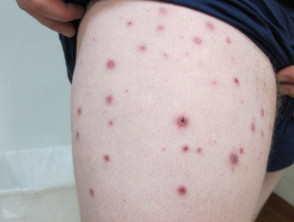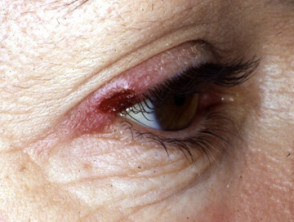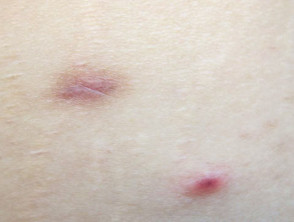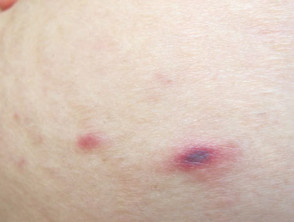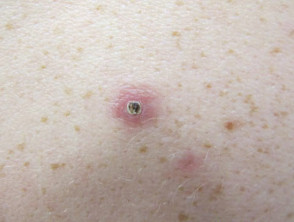What is lymphomatoid papulosis?
Lymphomatoid papulosis (LyP) is a rare form of indolent cutaneous T-cell lymphoma characterised by crops of recurrent self-healing papules. It is the most common type of primary cutaneous CD30+ lymphoproliferative disorder.
Lymphomatoid papulosis
Who gets lymphomatoid papulosis?
Lymphomatoid papulosis has an estimated incidence of 1.2–1.9 cases per million population. LyP can affect all races, although it is uncommon in skin of colour. Any age can be affected; the average age of onset is between 35 and 45 years. However, even children can present with lymphomatoid papulosis. Men are more commonly affected than women.
What causes lymphomatoid papulosis?
The aetiopathogenesis of primary cutaneous CD30+ lymphoproliferative disorders remains elusive. CD30 signalling is known to affect growth and survival of lymphoid cells. Some studies suggest restriction of the normal T cell repertoire in the peripheral blood. Other hypotheses implicate reactive phenomena inducing CD30+ overexpression.
What are the clinical features of lymphomatoid papulosis?
- Lymphomatoid papulosis presents as recurring crops of self-resolving papules that often ulcerate or become necrotic.
- Crops erupt with no clear initiating factor.
- The number of red-violaceous papulonecrotic or papulonodular lesions varies between just a few to hundreds.
- Lesions are mostly asymptomatic but some patients experience itch and pain associated with the ulceration, crusting, and necrosis.
- The eruption is usually generalised mainly over the trunk and extremities.
- Cases of localised and agminated LyP lesions have been reported.
- Ulcerated lesions heal spontaneously over 3–12 weeks to leave post-inflammatory hypo- or hyper-pigmentation and superficial varioliform scars. Non-ulcerated lesions can disappear without sequelae.
- Typically, LyP lesions at different stages of evolution coexist.
Evolution of lymphomatoid papules
Dermoscopy of lymphomatoid papulosis
- Initial inflammatory papule
- Tortuous irregular vessels radiating from the centre with a surrounding white structureless area
- Peripheral delicate dotted vascular pattern surrounding a central pink-light-brown homogeneous area
- Mature hyperkeratotic papule
- Central vascular component lost but may persist at periphery
- Central scales or crusts and peripheral rim resembling porokeratosis
- Persistent white structureless area
- Ulcerated stage
- Central necrotic ulceration or crust
- Brown-grey structureless area
- Peripheral vessels
- Cicatricial phase
- Brown macule lacking vascular pattern
What are the complications of lymphomatoid papulosis?
Lymphomatoid papulosis can be associated with other cutaneous or systemic lymphomas which may precede, accompany, or follow the diagnosis of LyP.
Quality of life can be impacted by cosmetically-troubling LyP lesions and scarring.
How is lymphomatoid papulosis diagnosed?
Diagnosis of lymphomatoid papulosis requires careful clinicopathological correlation. History, examination, and skin histopathology must be compatible. The diagnosis cannot be made on histology alone as similar findings can be seen in other skin conditions.
- Skin biopsy for histology and immunohistochemistry — multiple histological patterns have been recognised, the most common being the Type A classic form; dermal atypical CD30+ atypical cells are characteristic [see Lymphomatoid papulosis pathology]
- T-cell receptor (TCR) gene rearrangement to assess clonality
- Complete blood count and differential
- Comprehensive metabolic screen
- Lactate dehydrogenase
Imaging eg, CT or PET scans, and bone marrow examination is not indicated unless there are clinical features to suggest extracutaneous disease.
What is the differential diagnosis for lymphomatoid papulosis?
- Pityriasis lichenoides
- Primary cutaneous anaplastic large-cell lymphoma
- Reactive lymphoid hyperplasia secondary to insect bites, scabies, medications, or infections [see Cutaneous pseudolymphoma]
What is the treatment for lymphomatoid papulosis?
Currently there is no curative treatment for lymphomatoid papulosis, nor treatments that change the natural course of the disease, although healing can be accelerated and the frequency and/or severity of crops reduced by some therapies. A wait-and-see approach can be considered given the indolent course and common relapse after ceasing active therapies.
The choice of treatment and escalation of therapy should be made by weighing any potential risks against short-term benefits. Selecting an appropriate treatment modality will depend on a number of factors including, but not limited to, the extent of lesions, frequency of flares, and involvement of cosmetically sensitive or highly visible areas.
- Intralesional or potent topical steroids
- Antibiotics with anti-inflammatory effects, such as tetracyclines
- Phototherapy eg, narrowband UVB, PUVA
- Radiotherapy for regional LyP
- Systemic immunomodulatory therapies — methotrexate, bexarotene, interferon-alpha
- Brentuximab vedotin, an anti-CD30 monoclonal antibody linked to cytotoxic monomethyl auristatin E, selectively targets tumour cells expressing the CD30 antigen and can achieve a durable response. However, up to 65% of patients develop a peripheral neuropathy.
What is the outcome for lymphomatoid papulosis?
Despite the malignant appearance on histology, lymphomatoid papulosis typically has an indolent waxing and waning course lasting months or even decades before remitting. The five-year survival is estimated to be 100%.
Long-term follow-up and surveillance is required as up to 20% of cases progress to other forms of cutaneous or systemic lymphoma such as mycosis fungoides, Hodgkin lymphoma, primary cutaneous anaplastic large-cell lymphoma, or nodal anaplastic large-cell lymphoma. Risk factors for associated lymphoma include older age and the presence of a monoclonal TCR-gene rearrangement on skin biopsy. Progression to a second or third lymphoma can occur after a prolonged delay of five or more years.
